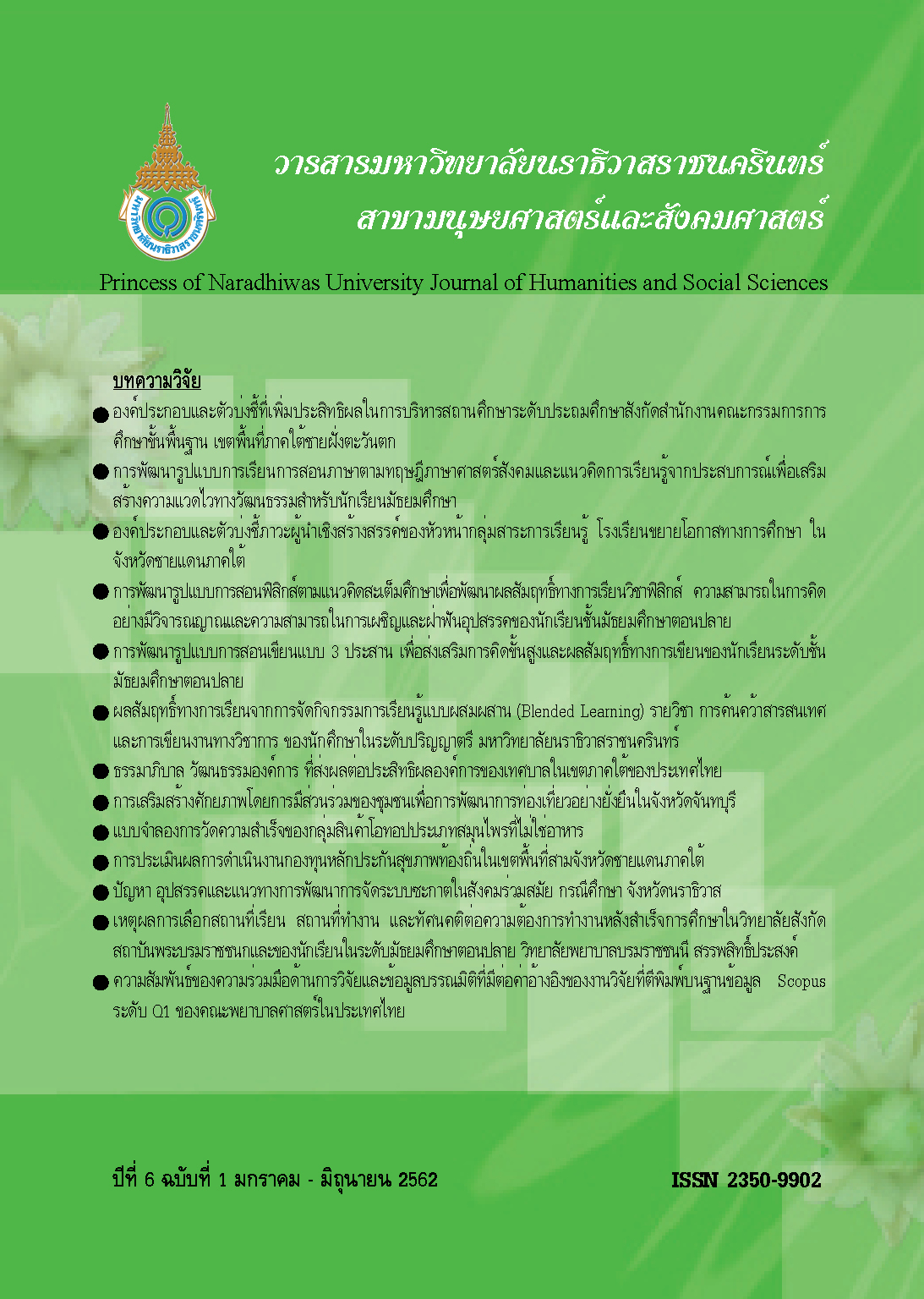Development of a Physics Instruction Model Based-on STEM Education Approach to Enhance Physics Learning Achievement, Critical Thinking, and Adversary Quotient of Upper Secondary Students
Main Article Content
Abstract
This research was a research and development. The aim of this research were (1) to develop Physics Instruction Model Based-on STEM Education Approach to Enhance Physics Learning Achievement, Critical Thinking, and Adversary Quotient of Upper Secondary Students (2) to evaluate the effectiveness of the developed instructional model.
The research procedure was divided into two phases. The first phase was the development of the instructional model that proceed in the following as: (1) the study of the concept and relevant literature to define the rationale of the constructional model, the objectives of the instructional model, the learning process, and the evaluation. (2) Examine the quality of the teaching model by expert evaluation. (3) Experiment with the instruction model by the pilot study. The sample consisted of 31 students in Mathayom Suksa 4/1 of Kraburiwittaya School in the second semester of the academic year 2016. The lesson plans based on the developed instruction model was used in this study. The results of the pilot study for improving the instruction model. The second phase was the evaluation of the developed instructional model by field try-out. The samples were 80 students in Mathayom Suksa IV of Kraburiwittaya school in the first semester of the academic year 2017, from cluster random sampling. The experimental design was the randomized pretest-posttest control group design. The instruments used in the study included (1) The Physics Achievement test with the reliability of 0.92. (2) The Critical Thinking test with the reliability of 0.98. and (3) The adversity Quotient Test by Kannika Suksamai (2006) with the reliability of 0.89. The data was analyzed by Multivariate Analysis of Variance (MANOVA)
The findings were as follows: 1) Physics Instruction Model Based-on STEM Education Approach to Enhance Physics Learning Achievement, Critical Thinking, and Adversary Quotient of Upper Secondary Students consisted of four components; (1.1) rationale of the constructional model (1.2) the objectives of the instructional model (1.3) learning process which comprised two steps. They were (3.1) problematic situation design which is creating a problem situation using the P-T-PM-E format and (3.2) the step of the learning process has consisted of 6 steps: Step 1 Identifying the problem, Step 2 Investigation, Step 3 Generating possible solutions, Step 4 Decision making, Step 5 Producing the product, Step 6 Performance assessment, and (1.4) evaluation 2) Physics learning achievement, critical thinking ability and adversary quotient of the students who were taught by the developed instructional model was significantly higher than of the students who were taught by the traditional teaching model.
Article Details
References
กระทรวงศึกษาธิการ. (2542). พระราชบัญญัติการศึกษาแห่งชาติ พุทธศักราช 2542 และที่แก้ไขเพิ่มเติม (ฉบับที่ 2) พุทธศักราช 2545. กรุงเทพฯ: โรงพิมพ์คุรุสภาลาดพร้าว
. (2552). หลักสูตรแกนกลางการศึกษาขั้นพื้นฐาน พุทธศักราช 2551. กรุงเทพฯ: โรงพิมพ์ชุมนุมสหกรณ์การเกษตรแห่งประเทศไทย.
กรรณิกา สุขสมัย. (2549). การพัฒนามาตรวัดความสามารถในการฝ่าฟันอุปสรรคตามทฤษฎีของสตอลทซ์
สำหรับนักเรียนช่วงชั้นที่ 4. วิทยานิพนธ์วิทยาศาสตรมหาบัณฑิต สาขาวิชาเทคโนโลยีการวัดทางการศึกษา.
บัณฑิตวิทยาลัย มหาวิทยาลัยบูรพา.
กฤษณา นันขันตี, นงนิตย์ มรกต, และ ชาติไทย แก้วทอง. (2555). การเปรียบผลการจัดกิจกรรมการเรียนรู้ เรื่อง เคมีอินทรีย์ กลุ่มสาระการเรียนรู้วิทยาศาสตร์ ชั้นมัธยมศึกษาปีที่ 6 ที่ได้รับการสอนแบบ 4 MAT กับที่ได้รับการสอนแบบปกติ. วารสารมหาวิทยาลัยนครพนม, 2(1), 85 - 92
จุติพร อัศวโสวรรณ, วัฒนา มัคคสมัน, ปรีชา เนาว์เย็นผล, และ สุมาลี กาญจนชาตรี. (2556). การพัฒนารูปแบบการเรียนการสอนแบบบูรณาการโดยการจัดประสบการณ์ตามแนวคิดคอนสตรัคติวิสต์ เพื่อพัฒนาการคิดวิเคราะห์และผลสัมฤทธิ์ทางการเรียนของนักเรียนชั้นประถมศึกษาปีที่ 3. วารสารมหาวิทยาลัยนราธิวาสราชนครินทร์, 5 (3), 81 - 95.
จินดา น้าเจริญ และ สุจินดา ขจรรุ่งศิลป์. (2556). รูปแบบการฝึกอบรมเพื่อส่งเสริมสร้างความสามารถในการเผชิญอุปสรรคในการปฏิบัติการสอน. วารสารศึกษาศาสตร์มหาวิทยาลัยทักษิณ, 13(1), 112 - 126
จินดาพร ไชยคำ, นุชวนา เหลืองอังกูร, และ บังอร กุมพล. (2560). ปัจจัยบางประการที่มีอิทธิพลต่อความสามารถในการเผชิญและฝ่าฟันอุปสรรค ของนักเรียนชั้นมัธยมศึกษาปีที่ 3 จังหวัดนครพนม. วารสารการวัดผลการศึกษา มหาวิทยาลัยมหาสารคาม, 23(ฉบับพิเศษ), 16 - 27
ชนาธิป พรกุล. (2554). การสอนกระบวนการคิด ทฤษฎีและการนำไปใช้. กรุงเทพฯ: สำนักพิมพ์แห่งจุฬาลงกรณ์มหาวิทยาลัย.
นิพนธ์ ชาญอัมพร, และ ธาตรี ใต้ฟ้ากูล. (2558). รูปแบบการดำเนินชีวิตและความคิดเห็นต่อรายการโทรทัศน์ของเด็กเจเนอเรชั่นแซด. วารสารการประชาสัมพันธ์และการโฆษณา, 8(2), 73-92.
พาสนา จุลรัตน์. (2556). เมตาคอกนิชันกับการเรียนรู้. วารสารวิชาศึกษาศาสตร์, 14(1), 1-17.
พิศิษฐ ตัณฑวณิช. (2558). แนวคิดการจำแนกพฤติกรรมการเรียนรู้ตามวัตถุประสงค์การจัดการศึกษาด้านพุทธิพิสัยตามแนวคิดของบลูมและคณะฉบับปรับปรุง. วารสารมหาวิทยาลัยราชภัฏลำปาง, 3(2), 13-25.
ไพฑูรย์ สินลารัตน์, นวลจิตต์ เชาวกีรติพงศ์, ทวีศักดิ์ จินดานุรักษ์, และ ไสว ฟักขาว. (2557). คิดวิเคราะห์:สอนและสร้างได้อย่างไร. กรุงเทพฯ: โรงพิมพ์แห่งจุฬาลงกรณ์มหาวิทยาลัย.
ศูนย์พัฒนาหลักสูตร กรมวิชาการ. (2543). การเรียนรู้เพื่อพัฒนากระบวนการคิด. กรุงเทพฯ: กรมวิชาการ กระทรวงศึกษาธิการ.
สถาบันส่งเสริมการสอนวิทยาศาสตร์และเทคโนโลยี. (2558ก). การติดตามผลการจัดการเรียนการสอนด้านวิทยาศาสตร์ คณิตศาสตร์ และเทคโนโลยีของครู ชั้นมัธยมศึกษาปีที่ 3 (ออนไลน์). ค้นเมื่อ 19 กรกฎาคม 2558 จาก ฝ่ายวิจัย สถาบันส่งเสริมการสอนวิทยาศาสตร์และเทคโนโลยี: www.research.ipst.ac.th
(2558ข). ความรู้เบื้องต้น สะเต็ม. กรุงเทพฯ: โรงพิมพ์ สกสค. ลาดพร้าว.
สิริวรรณ วงศ์พงศ์เกษม. (2554). ผลของโปรแกรมพัฒนาผู้เรียนที่มีต่อความสามารถในการเผชิญและฟันฝ่าอุปสรรคของนักเรียนชั้นมัธยมศึกษาปีที่ 1 โรงเรียนเซนต์ดอมินิก กรุงเทพฯ. วิทยานิพนธ์ศิลปศาสตรมหาบัณฑิต สาขาจิตวิทยาการศึกษาและการแนะแนว บัณฑิตวิทยาลัย มหาวิทยาลัยเกษตรศาสตร์
สำนักงานเลขาธิการสภาการศึกษา. (2552). การศึกษาองค์ความรู้เกี่ยวกับคุณลักษณะของคนไทยที่พึงประสงค์: ความสามารถในการเผชิญและฟันฝ่าอุปสรรค (Adversity Quotient: AQ). กรุงเทพฯ: บริษัท พริกหวานกราฟฟิค จำกัด.
สำนักทดสอบทางการศึกษา สำนักงานคณะกรรมการการศึกษาขั้นพื้นฐาน กระทรวงศึกษาธิการ. (2556). สรุปผลการประเมินคุณภาพภายนอกรอบสาม (พ.ศ.2554 - 2558)ของสถานศึกษาสังกัดสำนักงานคณะกรรมการการศึกษาขั้นพื้นฐาน ปี พ.ศ.2554. กรุงเทพ: บริษัท พริกหวานกราฟฟิค จำกัด.
อาดีละห์ เจ๊ะแม, ณัฐนี โมพันธ์, และ มัฮดี แวดราแม. (2561). ผลของการจัดการเรียนรู้โดยการสืบเสาะหาความรู้ (5Es) ที่มีต่อความเข้าใจธรรมชาติของวิทยาศาสตร์ ผลสัมฤทธิ์ทางการเรียน และเจตคติต่อวิทยาศาสตร์ ของนักเรียนชั้นประถมศึกษาปีที่ 6. วารสารมหาวิทยาลัยนราธิวาสราชนครินทร์, 5 (1), 11 - 23.
Eggen, P.D. & Kauchak, D.P. (2012). Strategies and Models for Teachers: Teaching Content and Thinking Skills. QUOTE ed. Boston: Pearson Education,Inc.
Joyce, B, & Weil, M. (1996). Models of teaching. QUOTE ed. Boston: Allyn and Bacon.
Kwan, Y. W., & Wong, A. F. (2015). Effect of the constructivist learning environment on student's critical thinking ability: Cognitive and motivational variables as meditors. International Journal of Educational Research 70, 68-79.
Lee, & Kamisah, (2015). An Interdisciplinary Approach for Biology, Technology, Engineering, Mathematics (BTEM) to Enhance 21 st Century Skill in Malaysia. K - 12 STEM Education, 1(3), 137 - 147.
National Research Council of The National Academies. (2011). SUCCESSFUL K - 12 STEM EDUCATION : Identifying Effective Approaches in Science, Technology, Engineering, and Mathematics. Washington, D.C.: THE NATIONAL ACDEMIES PRESS.
Robert, M. Mary, & James, R.(2013). STEM Project-Based Learning. An Integrated Science, Technology, Engineering, and Mathematics (STEM) Approach. Rotterdam: Sense Publishers.


